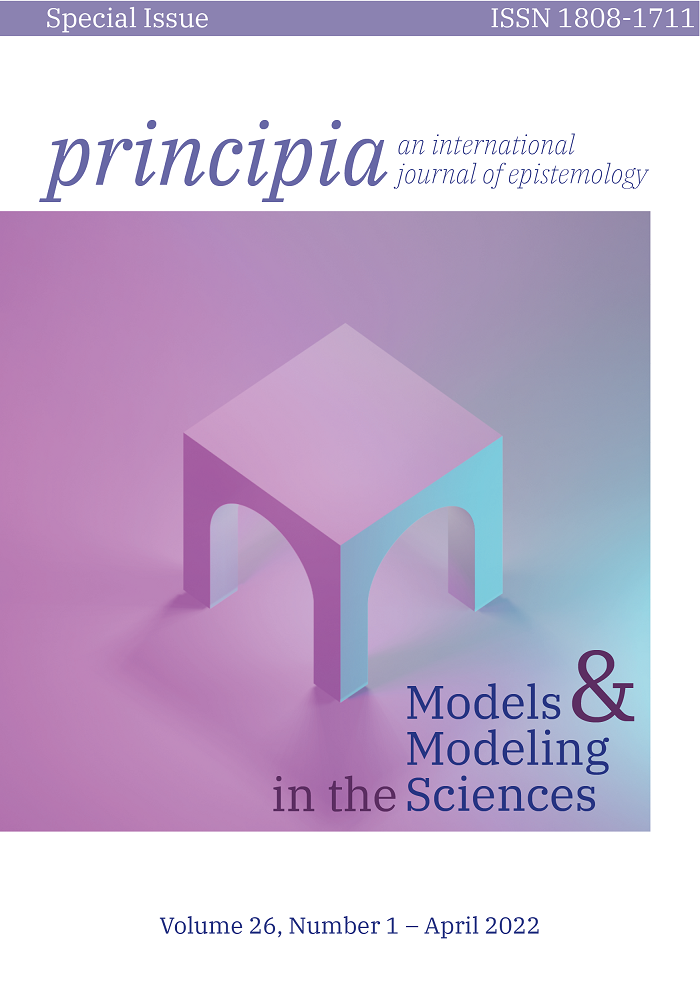Models and Modeling in Science: the role of metamathematics
DOI:
https://doi.org/10.5007/1808-1711.2022.e86052Palavras-chave:
Scientific theories, structures, models, set theories, categories, metaphysics, non-individuals, quasi-set theoryResumo
The use of models of scientific theories should not be done without qualifications about the mathematics being used to build the models. This looks obvious, at least for logicians, but generally, it is not to the philosopher of science. Thus, some details about this point seem useful for both. Since any quick revision in the literature shows that in most cases, mainly after the raising of the semantic approach (to scientific theories), the models are taken to be set-theoretical structures, in discussing the issue we shall be concerned more with set theories, the locus where the play is usually developed (yet sometimes unconsciously).
Referências
Ballentine, L. E. 1998. Quantum Mechanics: A Modern Development. Singapore: World Scientific Publishing Company.
Benioff, P. A. 1976. Models of Zermelo Fraenkel set theory as carriers for the mathematics of physics, i. Journal of Mathematical Physics, 17: 618–628.
Benioff, P. A. Models of Zermelo Fraenkel set theory as carriers for the mathematics of physics, ii. Journal of Mathematical Physics, 17: 629–640, 1976.
Bourbaki, N. 2006. Théorie des Ensembles. [1970, Paris: Hermann]. Berlin and Heidelberg: Springer-Verlag.
Button, T. & Walsh, S. 2018. Philosophy and Model Theory. Oxford: Oxford University Press.
da Costa, N. C. A. & Doria, F. A. 1992. Suppes predicates for classical physics. In J. Echeverria; A. Ibarra; T. Mormann (ed.). The Space of Mathematics: Philosophical, Epistemological, and Historical Explorations, p. 168–191. Berlin and New York: Walter de Gruyter.
da Costa, N. C. A. & Krause, D. 2020. Suppes predicates for classes of structures and the notion of transportability. In A. Costa-Leite (ed.). Abstract Consequence and Logics: Essays in Honor of Edelcio G. de Souza, p. 79–98. Tributes 42. London: College Publications.
Dalla Chiara, M. L. & di Francia, G. T. 1981. Le Teorie Fisiche: Un’Analisi Formale. Torino: Boringhieri.
Dalla Chiara, M. L. & di Francia, G. T. 1993. Individuals, kinds and names in physics. In G. Corsi; M. L. Dalla Chiara; G. C. Ghirardi (ed.). Bridging the Gap: Philosophy, Mathematics, and Physics, p. 261–284. Boston Studies in the Philosophy of Science 140. Dordrecht: Kluwer.
Enderton, H. B. 1977. Elements of Set Theory. New York, San Francisco, London: Academic Press.
Fraenkel, A. A.; Bar-Hillel, Y.; Levy, A. 1973. Foundations of Set Theory. 2nd Edition. Studies in Logic and the Foundations of Mathematics 67. Amsterdam: Elsevier.
Oliveira, A. J. F. 2010. Lógica e Aritmética: Uma Introdução à Lógica, Matemática e Computacional. 3rd Edition (revised and enlarged). Lisboa: Gradiva, Lisboa.
French, S. & Krause, D. 2006. Identity in Physics: A Historical, Philsophical, and Formal Analysis. Oxford: Oxford University Press.
Jech, T. J. 1977. About the axiom of choice. In J. Barwise (ed.). Handbook of Mathematical Logic, Studies in Logic and the Foundations of Mathematics, 90, p. 345-370. Amsterdam: North Holland.
Krause, D. 1990. Non-Reflexivity, Indistinguishability, and Weyl’s Aggregates (in Portuguese). PhD thesis, Faculty of Philosophy, University of São Paulo, August 1990.
Krause, D. 1992. On a quasi-set theory. Notre Dame Journal of Formal Logic 33(3): 402–411.
Krause, D. & Arenhart, J. R. B. 2017. The Logical Foundations of Scientific Structures: Languages, Structures, and Models. Routledge Studies in Philosophy of Mathematics and Physics. New York and London: Routledge.
Krause, D.; Arenhart, J. R. B.; Bueno, O. 2022. The non-individuals interpretation of quantum mechanics. In O. Freire Jr. (ed.). The Oxford Handbook of the History of Quantum Interpretation, Chapter 46, p. 1135–1154. Oxford: Oxford University Press.
MacLane, S. & Birkhoff, G. 1968. Algebra. 3rd printing edition. New York and London: The Macmillan Co. and Collier-Macmillan.
Maitland-Wright, J. D. 1973. All operators on a hilbert space are bounded. Bulletin of the American Mathematical Society 79(6): 1247–1251.
Mashaal, M. 2006. Bourbaki: A Secret Society of Mathematicians. Providence: American Mathematical Society.
Mendelson, E. 1997. Introduction to Mathematical Logic. 4th edition. London: Chapman and Hall.
Penrose, R. 2005. The Road to Reality: A Complete Guide to the Laws of the Universe. New York: Vintage Books.
Pogorelov, A. V. 1987. Geometry. Moscow: Mir Publishers.
Redhead, M. 1987. Incompleteness, Nonlocality, and Realism: A Prolegomenon to the Philosophy of Quantum Mechanics. Oxford: Clarendon Press.
Smith, P. 2021. Gödel Without (Too Many) Tears. Cambridge: Logic Matters.
Suppe, F. (ed.). 1977. The Structure of Scientific Theories. 2nd edition. Urbana and Chicago: University of Illinois Press.
Suppes, P. 1972. Axiomatic Set Theory. New York: Dover.
Suppes, P. 2002. Representation and Invariance of Scientific Structures. Stanford: Center for the Study of Language and Information, CSLI.
van Fraassen, B. 1980. The Scientific Image. Oxford: Oxford University Press.
Downloads
Publicado
Edição
Seção
Licença
Copyright (c) 2022 Décio Krause

Este trabalho está licenciado sob uma licença Creative Commons Attribution-NonCommercial-NoDerivatives 4.0 International License.

A obra Principia de http://www.periodicos.ufsc.br/index.php/principia/index foi licenciada com uma Licença Creative Commons Atribuição-NãoComercial-SemDerivações 4.0 Internacional.
Com base na obra disponível em www.periodicos.ufsc.br.



